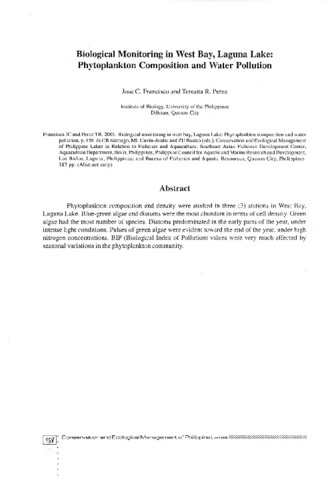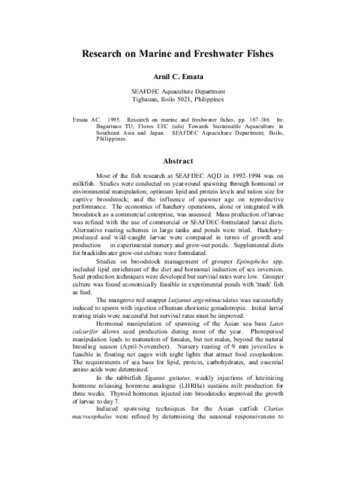Morphometric and morphomeristic variations in five populations of indigenous Celebes goby Glossogobius celebius (Perciformes: Gobiidae) from Southern Luzon, Philippines
| dc.contributor.author | Corpuz, Mark Nell C. | |
| dc.contributor.author | Camacho, Ma. Vivian C. | |
| dc.contributor.author | Ocampo, Pablo P. | |
| dc.date.accessioned | 2015-05-19T06:32:11Z | |
| dc.date.available | 2015-05-19T06:32:11Z | |
| dc.date.issued | 2013 | |
| dc.identifier.citation | Corpuz, M. N. C., Camacho, M. V. C., & Ocampo, P. P. (2013). Morphometric and morphomeristic variations in five populations of indigenous Celebes goby Glossogobius celebius (Perciformes: Gobiidae) from Southern Luzon, Philippines. Philippine Agricultural Scientist, 96(1), 75-85. | en |
| dc.identifier.issn | 0031-7454 | |
| dc.identifier.uri | http://hdl.handle.net/10862/2232 | |
| dc.description.abstract | To elucidate the population structure and pattern of morphological divergence of the indigenous Celebes goby Glossogobius celebius (Valenciennes, 1837), morphometric and morphomeristic characters of this species were compared among populations collected from five study sites in Southern Luzon, Philippines. Univariate analysis of variance confirmed significant differences among populations for 20 out of 23 allometrically-transformed metric characters (P<0.05), while nine meristic traits of five populations were comparatively homogeneous (P>0.05). Intrapopulation variability was very low (6.81-7.21%) for each location. Multivariate analysis of variance determined a very high significant group variability (P<0.05). Also, principal component analysis (PC1=36.60%; PC2=18.34%) and canonical variate analysis (CV1=44.59%; CV2=37.30%) identified the 2 super(nd) dorsal fin length, anal fin length, and the 2 super(nd) dorsal fin origin as the main significant contributors of population differentiation. Derived classification functions correctly classified an average of 68% individuals into their original groups. The canonical variate analysis plot exhibited high isolation of lacustrine populations (Lake Taal and Laguna de Bay) from riverine populations (Dampalit River, Alitaaw River and Pansipit River), with the latter having longer metric characters. Likewise, squared Euclidean distance similarity using metric data clearly produced two clusters representing both river and lake populations. This morphological divergence is suggested to be environmentally-induced (phenotypic plasticity) primarily by the differences in flow rate and temperature of the study sites. | en |
| dc.language.iso | en | en |
| dc.publisher | College of Agriculture, University of the Philippines Los Baños | en |
| dc.subject | Philippines, Luzon I., Alitaaw R. | |
| dc.subject | Philippines, Luzon I., Dampalit R. | |
| dc.subject | Philippines, Luzon I., Laguna de Bay L. | |
| dc.subject | Philippines, Luzon I., Pansipit R. | |
| dc.subject | Philippines, Luzon I., Taal L. | |
| dc.title | Morphometric and morphomeristic variations in five populations of indigenous Celebes goby Glossogobius celebius (Perciformes: Gobiidae) from Southern Luzon, Philippines | en |
| dc.type | Article | en |
| dc.citation.volume | 96 | |
| dc.citation.issue | 1 | |
| dc.citation.spage | 75 | |
| dc.citation.epage | 85 | |
| dc.citation.journalTitle | Philippine Agricultural Scientist | en |
| dc.subject.asfa | animal morphology | en |
| dc.subject.asfa | animal population | en |
| dc.subject.asfa | endemic species | en |
| dc.subject.asfa | freshwater fishes | en |
| dc.subject.asfa | freshwater lakes | en |
| dc.subject.asfa | meristic counts | en |
| dc.subject.asfa | phenotypic variation | en |
| dc.subject.asfa | population structure | en |
| dc.subject.asfa | rivers | en |
| dc.subject.scientificName | Glossogobius celebius | en |
Files in this item
| Files | ขนาด | รูป | View |
|---|---|---|---|
|
There are no files associated with this item. |
|||
รายการนี้ปรากฏใน (s)
-
Journal Articles [1258]
These papers were contributed by Department staff to various national and international journals.



